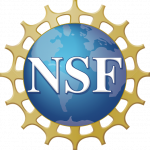Ocean Oxygen: Using forams to understand past, present, and future oceans

Presenters
Dr. Joan Bernhard, Woods Hole Oceanographic Institution Geology & Geophysics Department - Insights into the Lives of Forams, Versatile Microbes with a Big Fossil Record
Dr. Yi Wang, Tulane University Earth and Environmental Sciences Department - Forams in the Sediments: Witnesses and Recorders of Ocean Oxygen
Date: March 28, 2025
Lesson Plans and Classroom Activities
- Climate analysis using planktonic foraminifera, a classroom activity integrating science and mathematics.
- This Rutgers University classroom activity is geared towards middle school but can be scaled up. Students look at data from forams that form their test (shell) differently in response to water temperature.
- Background material for this lesson can be found at this University of California Museum website.
- Cupcake geology
- Inquiry-based scientific investigation using a “layered-Earth” cupcake to learn how scientists discover what is hidden beneath the seafloor.
- ORSEA: Forams as Storytellers.
- In this standards based high school lesson, students learn about marine heatwaves and how the distribution of foraminifera species in the fossil record and in deep sea sediment cores helps researchers understand changes in ocean climate.
- Climate Diaries of the Deep: Research on ancient environments
- This activity focuses on the use of data to study how Earth’s climate has changed over time. Students use foraminifera species sampled from Joides Resolution Expedition 342 to determine the age of the sediment and the climate conditions during the sample ages.
- Oxygen Isotopes Reveal Ancient Climates
- In this American Geosciences Institute, standards based, high school lesson, students will join scientists as they explore how deep ocean sediment cores are used to study microfossils, their ages, and their oxygen isotope ratios to study past climate change and make predictions about future patterns of change.
- A Technician’s Guide to Ocean Sediment Core Descriptions
- This lesson has students make visual core descriptions of ocean sediment cores to mimic the work of technicians on board research vessels that collect these cores. Students will work on making observations that will lead to making inferences about past environmental conditions.
Background and Resources:
- Bernhard, J.M. and Sen Gupta, B. K. (1999) Foraminifera of Oxygen-Depleted Environments. In: Sen Gupta, B.K. (Ed.) Modern Foraminifera, Kluwer Academic, pp. 201-216.
- This book is a great introduction to forams.
- Joan Bernhard’s Lab Webpage
- Yi Wang’s Lab Webpage
- Kelly, K. J., Kast, D. J., Schiksnis, C. A., & Thrash, J. C. (2023). Hands-on Hypoxia: Engaging High School Educators in the science behind Marine Microbial Dynamics in Hypoxic Coastal Areas Through Field and Classroom Experiences. Current: The Journal of Marine Education, 38(1), pp. 28–41. https://doi.org/10.5334/cjme.86
- What are forams? How are they studied?
- This Burke Museum website provides a good overview of foraminifera and how we collect and study their fossils.
- Why study forams?
- This resource provides a summary of different types of forams, where they are found, and what we can learn from them.
WHOI Oceanus Articles
- Mentors for Budding Scientists, 2012.
- Oceanus article highlighting student work and another way to use forams in climate science.
Deeper Exploration: Papers in Scientific Journals:
- Burke, J., Renema, W., Henehan, M., Elder, L., Davis, C., Maas, A., Foster, G., Schiebel, R., and Hull, P. (2018) Factors influencing test porosity in planktonic foraminifera, Biogeosciences, 15, 6607–6619, https://doi.org/10.5194/bg-15-6607-2018 (Copy included)
- Lu, W., Wang, Y., Oppo, D., Nielsen, S., and Costa, K. (2022) Comparing paleo-oxygenation proxies (benthic foraminiferal surface porosity, I/Ca, authigenic uranium) on modern sediments and the glacial Arabian Sea. Geochimica et Cosmochimica Acta 331: 69–85.
- Richirt, J., Champmartin, S., Schweizer, M., Mouret, A., Petersen, J., Ambari, A., and Jorissen, F. (2019) Scaling laws explain foraminiferal pore patterns. Scientific Reports 9, 9149. https://doi.org/10.1038/s41598-019-45617-x
- , Costa, K., & Oppo, D. (2023). Reconstructing the oxygen depth profile in the Arabian Sea during the last glacial period. Paleoceanography and Paleoclimatology, 38. https://doi.org/10.1029/2023PA004632


Workshop Agenda
Friday, March 28, 2025
8:45 – 9:15 -- Check-in at WHOI Clark Building, Room 507. Breakfast: pastries, coffee, juice, tea, water
9:15 – 9:30 --Introduction to WHOI Sea Grant and WHOI
9:30 – 10:30 -- Dr. Joan Bernhard, WHOI Geology & Geophysics Department
10:30 – 10:45 -- Break
10:45 – 11:45 -- Dr. Yi Wang, Tulane Earth and Environmental Sciences Department
11:45 – 1:00 -- LUNCH (provided). Chat with speakers, discuss classroom integration, and explore campus.
1:00 – 1:15 -- Split into afternoon sessions
1:15-3:30 -- Exploring related classroom activities and lab tours
3:30 - 4:00 -- Hand out PDPs and wrap up
